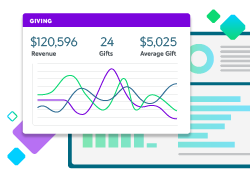Encouraging Donors to Participate in Corporate Giving Programs

Corporate giving opportunities like matching gift programs, volunteer grants, and fundraising event matches allow nonprofits, donors, and corporations to build and grow mutually beneficial partnerships.
By now, you likely understand the advantages of corporate giving to the businesses partaking—increased corporate social responsibility, cause marketing opportunities, improved public opinion—as well as to the nonprofits receiving the funds—additional revenue and strengthened relationships. But what exactly does the donor get out of the arrangement?
Essentially, corporate giving programs allow donors to make an increasingly significant impact on a cause they care about without having to contribute more financially.
Now, you might be thinking, “That sounds great! Why doesn’t everyone partake in those programs already?” In this guide, we’ll answer that question by addressing some of the most substantial roadblocks to donor participation in corporate giving. Then, we’ll share a few tried-and-true tips for simplifying the process and overcoming obstacles before they arise.
Ready to learn more about effectively encouraging donors to participate in employer giving programs? Let’s dive in.
Understand common roadblocks to corporate philanthropy.
The first step in maximizing corporate giving for your nonprofit is understanding what’s hindering its growth in the first place. For many donors, their lack of participation in relevant employer giving programs comes down to two things: lack of awareness and a complicated request process.
1. Lack of Awareness
According to these fundraising statistics from Double the Donation, over 18 million individuals work for companies with matching gift programs—but 78% of these match-eligible donors are unaware that these opportunities even exist. From these numbers alone, you can see that there’s a huge knowledge gap that’s obstructing maximum participation.
After all, you can’t expect a donor to request a corporate match for their gift if they’re completely unaware that their employer offers such a program.
2. Complicated Request Process
Even for donors who do know about corporate giving programs offered by their employers, the process isn’t always so cut and dry. Many of these individuals might even be interested in participating in workplace giving—but they’re not sure how to get started.
While some companies manage their employee giving programs through dedicated workplace giving platforms (and strategically communicate available corporate giving opportunities to eligible employees), other approaches might not be so organized. For those who fall into the latter category, the burden of informing donors and coordinating corporate giving efforts land largely with the nonprofits themselves.
Simplify the corporate giving process for donors.
A complicated process is keeping donors from participating in corporate giving—but how can you, as a nonprofit team, simplify it from start to finish? Consider the following best practices to streamline corporate philanthropy and maximize the number of dollars you receive from this avenue.
1. Educate donors on other corporate giving opportunities.
Because one of the main obstacles to maximizing corporate giving dollars is a lack of awareness, educating donors and supporters on these types of efforts is a critical first step.
Let’s explore a few of our favorite ways to get the word out about matching gifts:
- Online donation pages
- Confirmation screens
- Acknowledgment letter
- Dedicated corporate giving web pages
- “Ways to give” web pages
- Direct mail
- Social media
Effective educational practices like these often incorporate a combination of direct and mass marketing efforts. Your approach should also target a number of different supporter segments within your network—including donors who are in the process of giving, those who are considering making a gift, and those who have submitted a gift in the recent past.
2. Provide donors with the information they need to submit a request.
The exact matching gift request process varies depending on the company the donor works for. As a result, it can seem like an overwhelming task when you provide them with little to no guidance on next steps.
That’s why sharing detailed and relevant information about their employer’s giving program is critical. This is essentially broken down into two categories of information: whether their gift is eligible for a corporate match and how to go about submitting the request to their employer.
For example, when a donor indicates they’re interested in seeking a corporate gift match, they’ll need to consider the following key guidelines to determine if their contribution is eligible:
- Match minimums and maximums (i.e., greater than $50, less than $10,000)
- Match ratios (i.e., 2:1 for full-time employees, 1:1 for retirees)
- Match request deadlines (i.e., within the calendar year, six months following the donation)
- Types of eligible nonprofits (i.e., only educational institutions, any non-religious organizations)
Then, once they’ve established that their gift is eligible for a match, the donor has to actually request it from their employer. Again, to simplify the process, consider providing the following information:
- Direct links to online match request forms, if applicable
- Instructions to access an employee giving platform or other company-specific resources
- Contact information for a person within the company who coordinates the corporate giving programs to learn more
But how are you expected to keep track of all of this information? Donor research is critical, but it’s nearly impossible to manage without the right tools. That’s where a matching gift database comes in handy.
When you invest in a searchable employer database, you can embed the resource in your online donor materials and provide access to supporters. Then, all they have to do is type in their company name and they’ll be met with all of the above information.
3. Follow up with donors whose gifts might be eligible for a match.
When you include your searchable company database on your nonprofit website, donation form, and more, a number of donors will likely take the initiative to search for their employer and follow up on a match request. However, a passive approach like this one will still typically leave a good amount of potential corporate revenue on the table.
That’s why it’s important to proactively communicate with donors and encourage them personally to look into their matching gift eligibility.
We suggest segmenting your audience, and your messaging, into the following categories:
- Likely eligible for a match
- Likely ineligible for a match
- Unknown eligibility
This way, you can take a targeted approach for each donor when determining your next steps. For example, you might send out an email to all donors reminding them to check their matching gift status regardless of their likely eligibility. This method is quick, easy, and very low cost. Not to mention—an automation tool can handle the entire process, saving your team time and money.
On the other hand, you might reserve pricier tactics like direct mail outreach strategies (i.e., postcards, inserts, and matching gift letters) for those you believe will be eligible for a corporate match along with other high-value donors. Either way, be sure to direct them to your comprehensive employer database to learn more.
Especially in a world of pandemic and post-pandemic fundraising, making the most of every dollar you receive is critical.
If you’re not already prioritizing matching gift opportunities in your overall fundraising strategy, now is certainly the time to begin. And it all starts with promoting these programs to donors and encouraging them to participate. Good luck!
The Nonprofit CRM Built for Fundraisers
Find out how Blackbaud’s Raiser’s Edge NXT® fits your organization.

